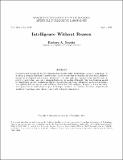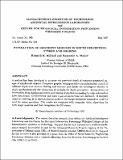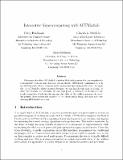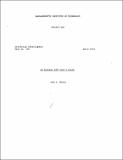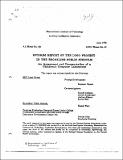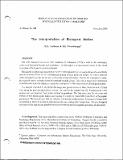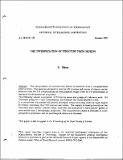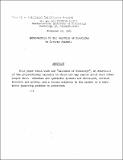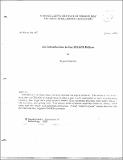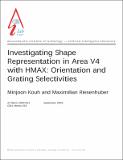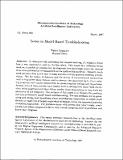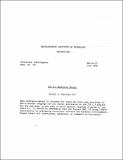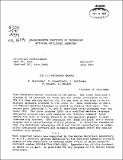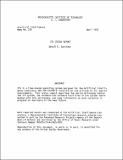Browsing AI Memos (1959 - 2004) by Title
Now showing items 500-519 of 1217
-
Intellectual Property and Software: The Assumptions are Broken
(1991-11-01)In March 1991 the World Intellectual Property Organization held an international symposium attended primarily by lawyers, to discuss the questions that artificial intelligence poses for intellectual property law (i.e., ... -
Intellectual Property in Computing: (How) Should Software Be Protected? An Industry Perspective
(1992-05-01)The future of the software industry is today being shaped in the courtroom. Most discussions of intellectual property to date, however, have been frames as debates about how the existing law --- promulgated long before the ... -
Intelligence in Scientific Computing
(1988-11-01)Combining numerical techniques with ideas from symbolic computation and with methods incorporating knowledge of science and mathematics leads to a new category of intelligent computational tools for scientists and ... -
Intelligence Without Reason
(1991-04-01)Computers and Thought are the two categories that together define Artificial Intelligence as a discipline. It is generally accepted that work in Artificial Intelligence over the last thirty years has had a strong influence ... -
Intelligent Assistance for Program Recognition, Design, Optimization, and Debugging
(1989-01-01)A recognition assistant will help reconstruct the design of a program, given only its source code. A design assistant will assist a programmer by detecting errors and inconsistencies in his design choices and by ... -
Interaction of Different Modules in Depth Perception: Stereo and Shading
(1987-05-01)A method has been developed to measure the perceived depth of computer generated images of simple solid objects. Computer graphic techniques allow for independent control of different depth queues (stereo, shading, ... -
Interactive Supercomputing with MIT Matlab
(1998-07-28)This paper describes MITMatlab, a system that enables users of supercomputers or networked PCs to work on large data sets within Matlab transparently. MITMatlab is based on the Parallel Problems Server (PPServer), a ... -
Interfacing the One-Dimensional Scanning of an Image with the Applications of Two-Dimensional Operators
(1980-04-01)To interface between the one-dimensional scanning of an image, and the applications of a two-dimensional operator, an intermediate storage is required. For a square image of size n2, and a square operator of size m2, ... -
An Interim LISP User's Guide
(1970-03-01)The substance of this memo is to initiate the naﶥ LISP user into the intricacies of the system at the Project MAC A.I. Lab. It is composed, at this time, of a Progress Report on the development of the LISP system and a ... -
Interim Report of the LOGO Project in the Brookline Public Schools
(1978-06-01)The LOGO activities of a group of 16 sixth-grade students, representing a full spectrum of ability, are being documented with a view to developing ways of capturing the learning possibilities of such an environment. The ... -
The Interpretation of Biological Motion
(1980-12-01)The term biological motion has been coined by G. Johansson (1973) to refer to the ambulatory patterns of terrestrial bipeds and quadripeds. In this paper a computational theory of the visual perception of biological ... -
The Interpretation of Structure From Motion
(1976-10-01)The interpretation of structure from motion is examined from a computational point of view. The question addressed is how the 3-D structure and motion of objects can be inferred from the 2-D transformations of their ... -
Introduction to the Calculus of Knowledge
(1961-11-01)This paper deals with the "Calculus of Knowledge", an extension of the propositional calculus in which one may reason about what other people know. Semantic and Syntactic systems are developed, certain theorems are proven, ... -
An Introduction to the EMACS Editor
(1978-01-01)EMACS is a real-time editor primarily intended for display terminals. The intent of this memo is to describe EMACS in enough detail to allow a user to edit comfortably in most circumstances, knowing how to get more ... -
Investigating shape representation in area V4 with HMAX: Orientation and Grating selectivities
(2003-09-08)The question of how shape is represented is of central interest to understanding visual processing in cortex. While tuning properties of the cells in early part of the ventral visual stream, thought to be responsible for ... -
Issues in Model Based Troubleshooting
(1987-03-01)To determine why something has stopped working, it's helpful to know how it was supposed to work in the first place. This simple fact underlies recent work on a number of systems that do diagnosis from knowledge about ... -
The Iterate Manual
(1990-10-01)This is the manual for version 1.1 of Iterate, a powerful iteration macro for Common Lisp. Iterate is similar to Loop but provides numerous additional features, is well integrated with Lisp, and is extensible. -
ITS 1.4 Reference Manual
(1968-06-01)This reference manual is intended for those who have some knowledge of PDP-6 machine language and are either interested in the ITS monitor for its own sake, or who wish to write machine language programs to run under it. ... -
ITS 1.5 Reference Manual
(1969-07-01)This reference manual consists of two parts. The first (sections 1 through 6) is intended for those who are either interested in the ITS 1.5 time sharing monitor for its own sake or who wish to write machine language ... -
ITS Status Report
(1972-04-01)ITS is a time-shared operating system designed for the Artificial Intelligence Laboratory DEC PDP-10/PDP-6 installation and tailored to its special requirements. This status report described the design philosophy behind ...




